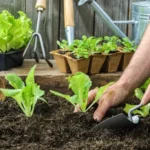Planting corn in your garden is just the beginning of a thriving, productive space. Choosing the right companions to grow alongside corn can boost growth, improve soil health, and even keep pests away. Knowing what to plant next to corn helps you create a balanced garden that maximizes yield and minimizes effort.
You don’t have to guess which plants work best with corn. Certain vegetables and herbs naturally support corn’s growth by providing shade, fixing nitrogen, or deterring harmful insects. By pairing corn with the right neighbors, you’ll enjoy a healthier, more vibrant garden all season long.
Benefits of Companion Planting with Corn
Companion planting with corn offers strategic benefits that boost your garden’s efficiency. You enhance growth, increase yield, and reduce pest problems when you pair corn with optimal plants.
Improving Growth and Yield
Companion plants like beans enrich soil nitrogen, which corn requires in high amounts. Beans fix nitrogen through root nodules, increasing nutrient availability, which directly boosts corn growth. Squash provides a living mulch by shading the soil, limiting weed competition and retaining moisture. When you combine corn with these plants, you create a mutually supportive environment that maximizes space and productivity.
Pest Control Advantages
Certain companions repel pests harmful to corn, reducing the need for chemical interventions. Herbs such as basil and mint emit strong scents that deter pests like corn earworms and aphids. Marigolds suppress nematodes and attract beneficial insects that prey on corn pests. By integrating pest-repelling plants next to corn, you protect your crop more naturally and encourage biodiversity in your garden ecosystem.
Best Plants to Grow Next to Corn in the Garden
Choosing the right companions for corn boosts your garden’s productivity and health. These plants support corn by enriching soil, providing shade, or deterring pests.
Beans and Peas
Beans and peas fix nitrogen in the soil, enhancing corn’s growth by supplying essential nutrients. Plant pole beans or climbing peas near corn; they use stalks as natural trellises, saving space and improving air circulation. This combination reduces the need for synthetic fertilizers and increases overall yield.
Squash and Pumpkins
Squash and pumpkins act as living mulch next to corn by shading the ground, suppressing weeds, and retaining soil moisture. Their broad leaves help maintain a cooler root zone for corn. Plant winter squash or pumpkins at the base of corn rows to maximize these benefits while producing additional crops.
Sunflowers
Sunflowers grow well beside corn by attracting pollinators and beneficial insects that reduce pest populations. Their sturdy stalks can serve as windbreaks, protecting corn plants from damage. Position sunflowers along garden edges or interplant within corn rows to enhance ecosystem balance and improve corn resilience.
Plants to Avoid Planting Next to Corn
Avoid selecting plants that hinder corn growth or compete excessively for resources. Knowing which plants to steer clear of helps protect your garden’s balance and boosts corn productivity.
Allelopathic Plants
Stay away from allelopathic plants like black walnut trees and sunflowers. These release chemicals into the soil that stunt corn growth and reduce nutrient availability. Avoid planting corn within close proximity to these plants to prevent inhibited development.
High Water-Consuming Plants
Avoid planting water-thirsty crops such as watermelon and cucumbers next to corn. These plants compete aggressively for moisture, causing stress to corn during dry periods. Maintaining adequate soil moisture for corn becomes difficult when paired with high water-consuming neighbors.
Tips for Successful Garden Layout with Corn
Designing a garden layout that complements corn maximizes growth, yield, and pest control. Focus on soil health, plant spacing, and timing for effective planting alongside corn.
Soil Preparation and Nutrient Management
Amend soil with organic matter to improve texture and fertility before planting corn and companions. Incorporate compost or well-rotted manure to supply essential nutrients. Rotate beans or peas with corn to naturally boost soil nitrogen levels. Test soil pH regularly, keeping it between 6.0 and 6.8 for optimal corn growth. Avoid heavy nitrogen fertilizers once corn emerges, as excessive nitrogen can favor leafy growth over ears. Mulch around corn and companion plants preserves moisture and suppresses weeds, aiding nutrient retention.
Proper Spacing and Planting Time
Space corn rows 30 to 36 inches apart, with plants 8 to 12 inches within rows to ensure adequate airflow and light penetration. Plant beans and peas close to corn stalks to use them as natural trellises, reducing the need for extra support. Sow squash or pumpkins at the garden edges with 24 to 36 inches between plants to provide effective ground cover without crowding corn. Time planting so corn emerges first, followed by companions within two weeks, ensuring corn’s initial growth isn’t overshadowed. Stagger planting if extending harvest periods or maximizing space in smaller gardens.
Conclusion
Choosing the right plants to grow next to your corn can make a big difference in your garden’s success. By carefully selecting companions that support growth, improve soil, and manage pests naturally, you create a thriving environment for your crops.
With thoughtful planning and proper spacing, you’ll maximize your garden’s productivity while reducing the need for chemicals. Embrace companion planting to enjoy a healthier, more vibrant garden season after season.

Hi, I’m Md Rofiqul, a gardening enthusiast who loves spending time in the garden and backyard. I enjoy caring for plants, growing flowers and vegetables, and creating a green space that feels peaceful and refreshing. Gardening is more than just a hobby, it’s a passion that connects me to nature and brings joy to my daily life. Living with plants inspires me to embrace simplicity, patience, and sustainability while making every day more colorful and rewarding.

